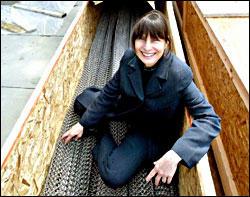 |
 |
 |
| HOME | McCaw Hall | Timelines | Events |
|
Sunday, June 22, 2003 By Melinda Bargreen
Those huge outdoor mesh screens that extend outward from the west side of McCaw Hall, above the heads of the incoming visitors, are among the most striking design elements of the new hall. Originally the concept of architect Mark Reddington, they were brought to life by Leni Schwendinger — an experienced lighting artist for opera and ballet who has worked at the Bayreuth Festival and who created the "fire" lighting for Seattle Opera's "Ring." She's also a former rock stagehand, and has done lighting projections for Ozzy Osbourne, Styx and Laurie Anderson. "The idea was to 'open up' the hall by giving those outside a look at what was happening inside," explains New York-based Schwendinger. At first, the idea was to open things up literally, by showing videos outside of the operas or ballets inside. LED (light-emitting diode) screens, like those billboards that transform from one image to the next, were "way too expensive," Schwendinger says. Yet, "We wanted to bring drama to the general public," says Schwendinger. "We asked ourselves, what is the simplest thing we could do? The answer was colored light. But we didn't want a million lights; they have to be changed and maintained, after all. We came up with 213 lights on nine scrims, with colored light that will pass through the scrims at an angle and then blend with other light in a Rothkoesque painting." Schwendinger created four sequences of lighting that she calls "melodies for the eyes." "I wanted recognizable color compositions, like a recognizable tune," she says. "I hope the public loves them and gets involved in viewing them, perhaps from a favorite place to stand." One lighting sequence evokes the Northern Lights with a sense of swirling movement. Vivid aquamarines dominate another, inspired by Wagner's Rheinmaidens, whose music "just haunts me," Schwendinger says. The colored lights won't be on all the time. "A 'white state' will be predominant," Schwendinger says, "because otherwise it'd be like hearing the same music over and over and over. Probably we'll have one sequence (of colored lights) per night, with lots of white space around. It will all be automated and pre-programmed." The programmed sequences are intended to be permanent, though theoretically they could be altered by a computer locked safely in the Phelps Center. The lights are located about 45 feet above the ground, and are engineered for wind. The scrims are made of stainless steel, the most weather-worthy substance available. Schwendinger had permanence in mind during the design and fabrication process. "I've wanted for a long time to move out of the theater and into the real world," she says of her work. "This project is such a great match for my interests and background."
|
|
|||||||||||||
seattletimes.com home
Home delivery
| Contact us
| Search archive
| Site map
| Low-graphic
NWclassifieds
| NWsource
| Advertising info
| The Seattle Times Company
